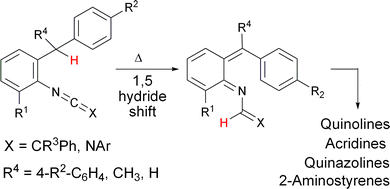Domino reactions initiated by intramolecular hydride transfers from tri(di)arylmethane fragments to ketenimine and carbodiimide functions†‡
Abstract
The ability of triarylmethane and diarylmethane fragments to behave as

* Corresponding authors
a
Departamento de Quimica Organica, Facultad de Quimica, Universidad de Murcia, Campus de Espinardo, Murcia, Spain
E-mail:
alajarin@um.es, vidal@um.es
Fax: + 34-868 364149
Tel: + 34-868887497, + 34-868887418
b
Servicio Universitario de Instrumentacion Cientifica, Universidad de Murcia, Campus de Espinardo, Murcia, Spain
E-mail:
raorenes@um.es
The ability of triarylmethane and diarylmethane fragments to behave as

 Please wait while we load your content...
Something went wrong. Try again?
Please wait while we load your content...
Something went wrong. Try again?
M. Alajarin, B. Bonillo, M. Ortin, P. Sanchez-Andrada, A. Vidal and R. Orenes, Org. Biomol. Chem., 2010, 8, 4690 DOI: 10.1039/C0OB00193G
To request permission to reproduce material from this article, please go to the Copyright Clearance Center request page.
If you are an author contributing to an RSC publication, you do not need to request permission provided correct acknowledgement is given.
If you are the author of this article, you do not need to request permission to reproduce figures and diagrams provided correct acknowledgement is given. If you want to reproduce the whole article in a third-party publication (excluding your thesis/dissertation for which permission is not required) please go to the Copyright Clearance Center request page.
Read more about how to correctly acknowledge RSC content.
 Fetching data from CrossRef.
Fetching data from CrossRef.
This may take some time to load.
Loading related content
